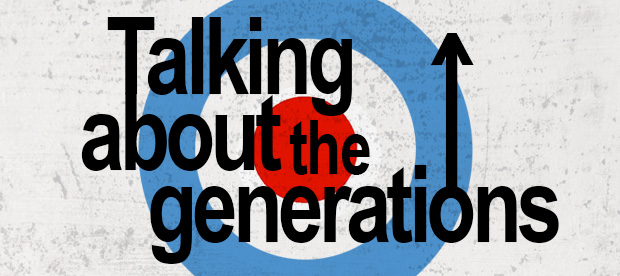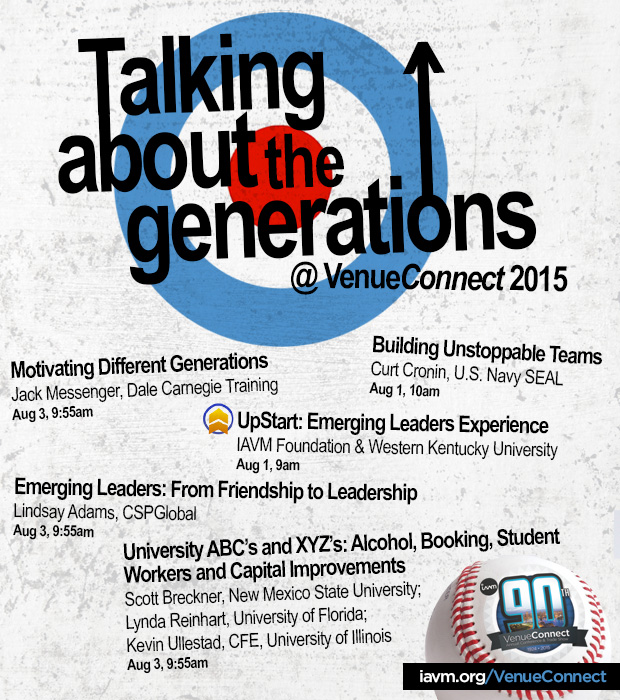Podcast: The Venue, Episode 1
We debuted our new live, call-in podcast, The Venue, last week. We had a blast interacting with members, and we’ve already upgraded our equipment (to get rid of those pesky echoes) for the next episode.
In case you missed the live version, you can listen to the recording above and hear what the Wolfe, myself, and members had to say about live-streaming, selfie-sticks, and comedians.
A shout out, also, to Chuck Tate—house manager and event supervisor at the Luther F. Carson Center for the Performing Arts in Paducah, Kentucky—for being our first call-in member. Thank you for participating.
We plan to have The Venue up on iTunes soon, and we’re looking at recording an episode at Venue Management School next week. Stay tuned!
Leadership Lessons for the Ages
I think I figured out why Millennials are being talked about again in such quantity—it’s because it’s graduation season. They’re entering the workforce. Or maybe they’re already a part of your organization. Nevertheless, you, as a venue manager, will be working with them, so it’s imperative you understand how to motivate and engage them.
However, it’s not just Millennials you have to consider. The Baby Boomers are still working, and more people from that generation are retiring later in life. Then you have the Gen X crowd to accommodate.
One of the ways we’re helping you manage different generations in your organization is through a training session at VenueConnect 2015 in Baltimore, Aug. 1-4. Jack Messenger, vice president of instruction and a certified trainer at Dale Carnegie Training, will lead a discussion on “Motivating and Engaging Different Generations.”
For example, Millennials want a workplace environment that offers flexible hours to allow a work-life balance, managers who trust them to do their work, and the availability of incentives for higher performance, according to a Dale Carnegie Training white paper.
And since more Millennials are in the workplace, that means more of them are in leadership roles. For young professionals, we’re offering a seminar called “From Friendship to Leadership,” led by Lindsay Adams, CSPGlobal, a principal at Teamocracy in Australia. Attendees will learn the essential traits of leadership, the must-do actions of leaders, and the critical items new leaders must avoid.
But wait, there’s more.
U.S. Navy SEAL Curt Cronin will present a session titled “Building Unstoppable Teams,” during which he’ll introduce to attendees an integrated leadership framework that identifies the key values, tasks, actions, disciplines, and attitudes required for success for any generation.
Then we’ll also offer more leadership training with the session, “You Can’t Make Omelettes Without Breaking Eggs: The Messy Work of Refining Your Leadership” Attendees at this session—led by Adams and Paul Bridle, CEO of Excellence Squared Limited—will learn how connecting people, processes, and performance creates profits and how identifying the right measurements and engaging people drives better results.
Whether you’re a current leader or a leader on the rise, VenueConnect offers several sessions to help you be successful. Register now, and we’ll see you in Baltimore!
30|UNDER|30 Spotlight: Dani Cole
Our latest recipient spotlight of the IAVM Foundation’s inaugural class of 30|UNDER|30 is Dani Cole, sales manager at the Tacoma Dome and the Greater Tacoma Convention & Trade Center in Washington.
“We’re in an industry where there are always new trends, new technology, and new expectations that the clients are bringing us,” Cole said when asked what she feels is necessary for future success in the venue management industry. “It is imperative that we are continuing to educate ourselves, that we aren’t allowing ourselves to become complacent or stale, that we are always learning what all these new trends are so that we can create new and exciting experiences every time someone walks in our door. If we can do this, I know that we will stay relevant, we will be competitive, and that we will be remembered.”
One of the benefits of being named a 30|UNDER|30 recipient is a full complimentary registration to VenueConnect in Baltimore. However, Cole will not be able to attend because her two-year-old daughter, Emmy, was recently diagnosed with neuroblastoma, a form of cancer.
Cole created a CaringBridge page to help friends and family stay up-to-date on Emmy.
“If you would like to leave words of encouragement for Emmy or the family on social media please tag #TeamEmmyCole so that when she grows up and looks back at this time in her life she can easily find your messages online,” Cole wrote the page. “Many people have asked how they can help our family, here are two sites that that have been setup by loved ones. If you would like to make a monetary donation please visit http://www.gofundme.com/teamemmycole, or if you would like to provide a meal please visit http://www.takethemameal.com/meals.php?t=HSMZ2586.”
Our thoughts and prayers are with the Cole family and for Emmy’s health.
IAVM Announces the 2015-2016 Slate of Officers
In accordance with IAVM policies and bylaws, the slate for the 2015-2016 Board of Directors is now available online. As in previous years, members will have an opportunity to cast their votes electronically in advance of VenueConnect in Baltimore, Maryland, Aug. 1-4, 2015.
“Members can read about the candidates online during their leisure and then cast their votes,” said Vicki Hawarden, CMP, IAVM president and CEO. “In addition, we will capture numerous more votes than would typically be counted onsite during a meeting.”
The ballot box will open soon, but in the interim take advantage of the opportunity to read all about those individuals slated to lead the Association during the next year.
Developing Communications Training for Event Day Personnel
I tell my management team and our part-time staff that the real purpose of my job is to help them be excellent in their jobs. Everything that we do as a management team is ultimately focused on ensuring that our front-line staff and their supervisors are put in a position to be successful. After all, the event day personnel are the ones that are face to face with our customers, our season ticket holders, our sponsors’ constituents. If they fail to execute, then the entire enterprise is a failure.
That mindset has always kept me interested and focused on staff training and development. I am in a constant search to find ways that we can better prepare our staff to meet the challenges and expectations that we have for them. They come to us with a variety of backgrounds and a spectrum of skills. And from this vast diversity, we seek to get uniform, high quality results. Then there is the other bit where we are limited on the amount of time and money we can spend on preparing them (training them) to do the job and the bit where they only do the job a few times a year (in my case the average staff member works about 17 events annually). Oh, and there is quite a lot of turnover. No matter how good you are, the event day personnel come and go (and go, and go).
So that’s the big puzzle. How do you take a transient labor force with a variety of skill and experience level, train them efficiently and then mobilize them periodically and expect them to deliver world-class service and experiences to your guests who have paid hundreds and thousands of dollars to attend the event? After more than 26 years of working at this, I have made some progress but I do not think I will ever figure it all out. But how I do love the challenge.
It is now June, and we at AT&T Stadium are preparing for the next season of events. We operate all year long, but the NFL season is the natural start of our event year. So the months of July and August are when we do a lot of event day staff training and ready for the coming 12 months of football, concerts, motor sports, corporate events, and everything else.
June is a chance for us to evaluate our training programs and make adjustments. This is our shot to again try and find that magic formula that will help us create that world-class service workforce. As I took inventory of our training programs, I came to realize that we had a big piece missing. And my guess is that most venue managers probably have the same piece missing from their trainings as well.
While we are diligent about teaching our staff the ins-and-outs of ushering, security, ticket taking, guest services, and the like, we have failed to teach them how to interact with our guests. Sure, we give them some guidelines—“Be helpful, smile, answer questions, be attentive.” But we don’t go much deeper. Why not? These staff members will spend almost 100 percent of their time interacting with our guests. Why don’t we spend more training time showing them what we want them to do and what we do not want them to do? Well, I intend on doing just that.
I have just finished creating a new training module entitled, “Communicating Effectively with Guests.” My academic background (albeit long, long ago) is in speech communication. So this topic is familiar waters for me. But the challenge was finding out what elements of communication skills training were best applicable in a venue setting, especially given the time constraints for the actual training session.
I arrived at a program that will take about 30 minutes to deliver. The communication training is built around the concepts of EMPATHY, EFFECTIVE COMMUNICATION STRATEGIES, and PHRASES THAT “WIN THE DAY.” The empathy component seeks to get the staff members to approach situations from the guest’s point of view. Far too often, we need to deal with staff who have been a little heavy handed or who have intervened in a situation only to inflame it. My hope is that we can stress the need to “put yourself in the guest’s shoes” and let that inform your interaction. The effective communication strategies component imparts some human psychology that affects communication. These are not haughty academic ideas. They are simple concepts like “Don’t tell people what to do; instead give them choices,” and “Don’t make threats; express appreciation and seek cooperation.” The last part, entitled Phrases that “Win the Day,” consists of carefully scripted responses to some typical guest interactions. The idea here is to arm the staff with some specific things to say that will get maximum results. The expectation is that the staff members will also use their experiences and this communications training to build their own phrases that “Win the Day.”
I’ve been in this business long enough to know that a training session will not ensure success. Training only becomes effective if there is systematic reinforcement of the training materials and active encouragement of the application of the training content. To that end, I have created a piece called the “Two Minute Drill” that serves as a training reminder/reinforce that we can implement on event day. Since we are an NFL stadium, we use a lot of football-themed things. Like the two-minute drill in football that is designed to elegantly use a limited amount of time to get the maximum yardage possible, the training version of the two-minute drill uses a couple of minutes from the supervisor’s crew briefing to refresh and reinforce the training content. The training program will be delivered as part of the staff training starting in July. Then at an event in October or November, we will roll out the “Two Minute Drill” piece on “Communicating Effectively with Guests.” We’ll see how it all goes.
If you are interested in receiving a copy of the “Communicating Effectively with Guests” training materials, I am willing to share. You can contact me at pturner@dallascowboys.net, and I will email it to you. I only ask for two things in return: No 1—If you have any feedback, corrections, or suggestions to my materials that I send you, then you are obligated to write or call me and share it with me. No. 2—If you have something that you have created and are willing to share, then send something to me. We must never take credit for someone else’s work, but we should be open to being inspired by it.
Be well.
(Image: Amy Wagliardo/Creative Commons)
Do you want to receive a Front Row News weekly digest?
Categories
- Allied (861)
- Architecture (147)
- Arenas (747)
- Career (897)
- Convention Centers (895)
- Education (623)
- Events (1,544)
- Food & Beverage (193)
- Foundation (113)
- Guest Experience (1,496)
- Industry News (2,270)
- Leadership (1,888)
- Marketing (150)
- Membership (2,000)
- Music (213)
- Performing Arts Centers (454)
- Professional Development (409)
- Research (127)
- Safety & Security (442)
- Sports (763)
- Stadiums (608)
- Student (159)
- Technology (516)
- Ticketing (92)
- Touring (82)
- Trends (364)
- Uncategorized (745)
- Universities (218)
- Video (25)
- Young Professional (198)
Twitter Feed
- Twitter feed loading
Recent Posts
- VenuWorks Selected To Manage Historic Paramount Arts Center In Ashland
- Miami Beach Convention Center Wraps a Milestone Year
- Venuworks and ATG Entertainment Selected to Manage Fresno Convention and Entertainment Center
- Seattle Convention Center Announces Strategic Leadership Appointment and Growth Initiatives for 2026
- Peggy Daidakis Humbly Made Convention Center History
Categories
- Allied
- Architecture
- Arenas
- Career
- Convention Centers
- Education
- Events
- Food & Beverage
- Foundation
- Guest Experience
- Industry News
- Leadership
- Marketing
- Membership
- Music
- Performing Arts Centers
- Professional Development
- Research
- Safety & Security
- Sports
- Stadiums
- Student
- Technology
- Ticketing
- Touring
- Trends
- Uncategorized
- Universities
- Video
- Young Professional
Archives
- January 2026
- December 2025
- November 2025
- October 2025
- September 2025
- August 2025
- July 2025
- June 2025
- May 2025
- April 2025
- March 2025
- February 2025
- January 2025
- December 2024
- November 2024
- October 2024
- September 2024
- August 2024
- July 2024
- June 2024
- May 2024
- April 2024
- March 2024
- February 2024
- January 2024
- December 2023
- November 2023
- October 2023
- September 2023
- August 2023
- July 2023
- June 2023
- May 2023
- April 2023
- March 2023
- February 2023
- January 2023
- December 2022
- November 2022
- October 2022
- September 2022
- August 2022
- July 2022
- June 2022
- May 2022
- April 2022
- March 2022
- February 2022
- January 2022
- December 2021
- November 2021
- October 2021
- September 2021
- August 2021
- July 2021
- June 2021
- May 2021
- April 2021
- March 2021
- February 2021
- January 2021
- December 2020
- November 2020
- October 2020
- September 2020
- August 2020
- July 2020
- June 2020
- May 2020
- April 2020
- March 2020
- February 2020
- January 2020
- December 2019
- November 2019
- October 2019
- September 2019
- August 2019
- July 2019
- June 2019
- May 2019
- April 2019
- March 2019
- February 2019
- January 2019
- December 2018
- November 2018
- October 2018
- September 2018
- August 2018
- July 2018
- June 2018
- May 2018
- April 2018
- March 2018
- February 2018
- January 2018
- December 2017
- November 2017
- October 2017
- September 2017
- August 2017
- July 2017
- June 2017
- May 2017
- April 2017
- March 2017
- February 2017
- January 2017
- December 2016
- November 2016
- October 2016
- September 2016
- August 2016
- July 2016
- June 2016
- May 2016
- April 2016
- March 2016
- February 2016
- January 2016
- December 2015
- November 2015
- October 2015
- September 2015
- August 2015
- July 2015
- June 2015
- May 2015
- April 2015
- March 2015
- February 2015
- January 2015
- December 2014
- November 2014
- October 2014
- September 2014
- August 2014
- July 2014
- June 2014
- May 2014
- April 2014
- March 2014
- February 2014
- January 2014
- December 2013
- November 2013
- October 2013
- September 2013
- August 2013
- July 2013
- June 2013
- May 2013
- April 2013
- March 2013
- February 2013
- January 2013
- May 2012
- March 2012
- December 2011
- November 2011
- October 2011
Recent Comments
- Frank Bradshaw, Ph.D., CVE on John Meyer, CVE, a Tireless Advocate of Certification for Venue Professionals, Has Died
- Neil Sulkes on Hilary Hartung, Friend to Many in Venue Marketing, Has Left Us
- Jason Parker, CVE on The Devastation of Hurricane Helene and How We Can Support One Another
- Larry Perkins on Touhey Testifies Against Speculative Ticketing Before Congressional Subcommittee
- Peter Secord on Major Players for Planned Elkhart Amphitheater Were in the Mix at VenueConnect





